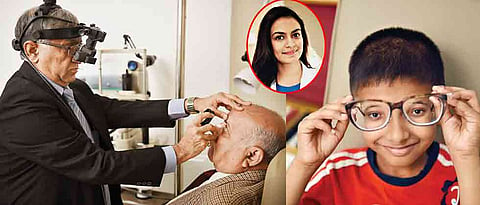

World Glaucoma Week, which will be celebrated from March 10-16, 2019, aims at eliminating glaucoma blindness by encouraging people to have regular eye check up, including optic nerve examination. Glaucoma is a term used to describe a group of diseases of the eye, characterised by progressive and irreversible damage to the optic nerve which, if untreated, may lead to blindness.
According to WHO, there are several types of glaucoma, and the two most common are primary open angle glaucoma (POAG), having a slow and insidious onset, and angle closure glaucoma (ACG), which is less common and tends to be more acute.
Glaucoma is the second most common cause of blindness worldwide. WHO has estimated that 4.5 million people are blind due to glaucoma. Little is known about its prevention, however, early diagnosis and treatment is the best way to prevent vision loss from glaucoma.
To spread awareness, Moolani’s Eye Care Centre, Camp, Pune, is organising a cycle rally and free eye screening during World Glaucoma Week. Dr Samita Moolani Katara, a consulting ophthalmologist at the eye care centre, tells us more about glaucoma and how early diagnosis is crucial.
Why is glaucoma called the ‘silent thief of sight’?
The most common type of glaucoma, known as open angle glaucoma, usually presents with absolutely no symptoms. The patient may not experience any visual difficulties, pain or discomfort until the end stage of glaucoma by which time it is too late and glaucoma has already permanently damaged vision. This is why it is known as the ‘silent thief of sight’.
How many in India suffer from glaucoma and what is the age group that is mostly affected?
Approximately 12 million Indians are affected and 1.2 million are blind (according to National Health Portal of India) due to glaucoma making it one of the leading causes of preventable blindness in India and the world.
A majority of patients are 40 and older, however, glaucoma can affect anyone.
Why does one suffer from glaucoma and what are the symptoms?
There are several types of glaucoma — childhood glaucoma, narrow angle glaucoma, open angle glaucoma. Glaucoma is due to a reduced drainage of the fluid in the eye leading to a pressure build up inside. This pressure in turn affects the optic nerve, damaging it and reducing vision. Initially, peripheral vision is lost and if not treated continues to damage central vision. Vision loss is not reversible and is permanent.
Rarely, early glaucoma may have symptoms of haloes or fluctuation of spectacle number.
People with high power in spectacles are at risk of developing glaucoma. Those with family history also are at risk.
Open-angle glaucoma usually remains asymptomatic.
Other forms of glaucoma may present with pain and redness which is why the main concern for screening is the silent type or open angle type of glaucoma.
Glaucoma is commonly referred to as ‘kaanch bindu’ or ‘kaala motiya’.
Can glaucoma be treated permanently? To keep the disease at bay, what are the precautions one must take?
Early diagnosis and treatment can help save sight and stop vision loss.
Open angle glaucoma is controlled in majority cases with pressure lowering eye drops. As the eye drops available in the market are very effective, the number of patients requiring surgery for glaucoma has reduced. However, in those patients where eye drops are not effective or those unable to put eye drops due to high cost or physical restraints, surgery is a safe and efficient option.
Once diagnosed with glaucoma constant and regular check-ups to monitor eye pressure, visual field damage and nerve damage will be recommended to make sure that there is no further progression.
Other forms of glaucoma may require laser surgery, or other surgical interventions.
What is the level of awareness of glaucoma in India?
Unfortunately, 90 per cent of glaucoma remains under diagnosed. We need to make more people aware of the importance of regular eye testing with a qualified ophthalmologist. Early detection can save sight and reduce the number of cases of preventable blindness.
Tell us a little about World Glaucoma Week 2019 and the cycle rally and free eye screening event that you are organising.
World Glaucoma Week is an initiative of the World Glaucoma Association, celebrated every year. We take this opportunity to highlight the importance of glaucoma awareness and conduct free screening.
Last year, we organised our first cycling rally campaign for glaucoma awareness. It was very well received and we distributed informative brochures and offered free screening for all patients. At the centre, we screened about 200 patients for free along with subsidised diagnostic testing and treatment.
What is the idea behind organising the cycle rally? Who all can take part?
This year, we are holding the rally on March 10, Sunday. We flag off at 5 pm from below our eye centre and will cycle around the area to raise awareness. Everyone is welcome to join us. Our supporters, friends, family and patients will get together to make this event a success.
— As told to Amrita Prasad
ST READER SERVICE
Cycle rally will be held on March 10 at 5 pm and free eye screening will be conducted at Moolani’s Eye Care Centre, Camp, Pune, on March 13 and 14, 9 am-4 pm. For registrations, call on 9511824124, 26353313, 26341025.
